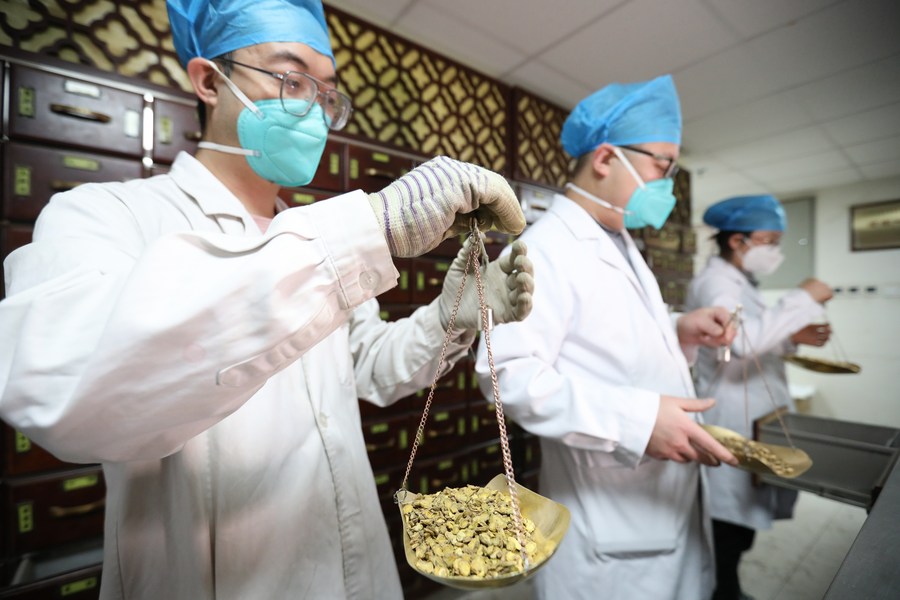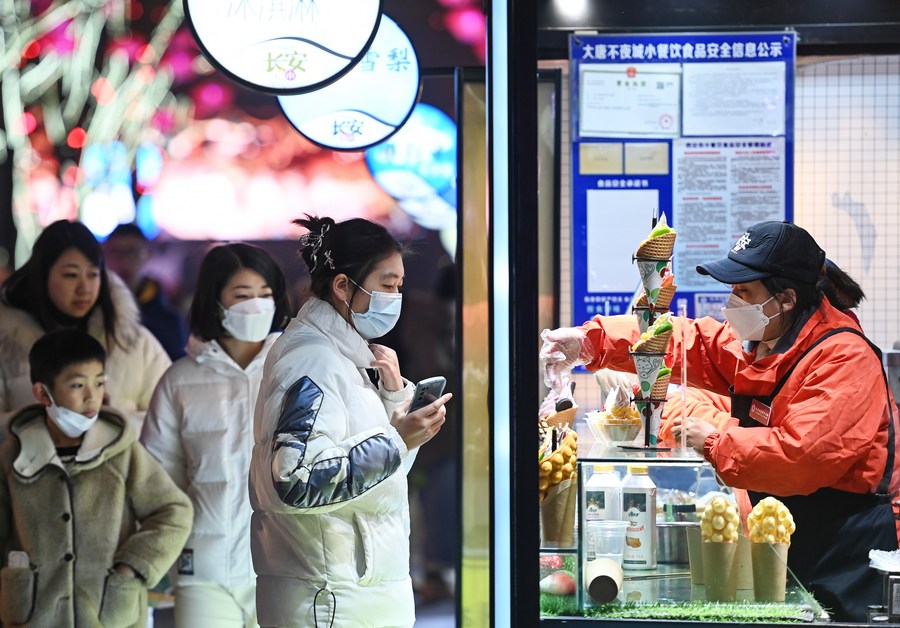China enters new phase of COVID response
* Considering factors including the development of the epidemic, the increase in vaccination levels, and extensive epidemic prevention experience, China has entered a new phase of COVID response.
* The focus of China's new phase of COVID-19 response is on protecting people's health and preventing severe cases.
* Through optimizing prevention and control measures, China has been injecting vitality into its economy.
BEIJING, Jan. 8 (Xinhua) -- From Sunday, China starts managing COVID-19 with measures designed for combating Class B infectious diseases, instead of Class A infectious diseases.
In recent months, the country has made an array of active adjustments in its COVID response, ranging from 20 measures in November, 10 new measures in December, changing the Chinese term for COVID-19 from "novel coronavirus pneumonia" to "novel coronavirus infection," and downgrading COVID-19 management measures.
Confronted with epidemic uncertainties, China has always been putting people's lives and health first, adapting its COVID response in light of the evolving situation. These efforts have bought precious time for a smooth transition in its COVID response.

Pharmacists prepare traditional Chinese medicine at Affiliated Hospital of Gansu University of Chinese Medicine in Lanzhou, northwest China's Gansu Province, Dec. 23, 2022. (Xinhua/Ma Xiping)
SCIENCE-BASED DECISION MAKING
The year 2022 saw the rapid spread of the highly-contagious Omicron variant.
The fast-changing features of the virus and the complicated evolution of epidemic response posed serious challenges for China's decision-makers, who have been closely following the epidemic situation and putting the people's lives and health first.
Twenty adjusted measures were announced as early as November 2022. They included the measure to adjust the categories of COVID-19 risk areas from high, medium, and low, to only high and low, in order to minimize the number of people under quarantine or requiring health monitoring. The circuit breaker mechanism for inbound flights was also canceled.
The adjustment was made based on a scientific evaluation of the Omicron variant which showed that the virus had become less deadly, and the social cost of sustaining the prevailing epidemic control which had rapidly increased.
Meanwhile, task forces were dispatched nationwide to supervise epidemic response and assess local situations, and meetings were held to solicit suggestions from leading medical experts and community epidemic control workers.
On Dec. 7, China released a circular on further optimizing its COVID-19 response, announcing 10 new prevention and control measures to ease restrictions on visits to public venues and travel, and to reduce the scope and frequency of mass nucleic acid testing.
The annual Central Economic Work Conference, held in Beijing in mid-December, demanded efforts to optimize epidemic response based on the prevailing situation and with focus on the elderly and those with underlying diseases.
Under such guiding principles, various sectors of the country, from hospitals to factories, have been mobilized to support continuous adjustment of epidemic control.
Considering factors including the development of the epidemic, the increase in vaccination levels, and extensive epidemic prevention experience, the country entered a new phase of COVID response.
Against such a backdrop, in late December, the National Health Commission (NHC) made the announcement to downgrade the management of COVID-19 and remove it from infectious disease management requiring quarantine as of Jan. 8, 2023.
"When an infectious disease poses less harm to people's health and leaves a lighter impact on the economy and the society, it is a science-based decision to adjust the intensity of prevention and control measures," said Liang Wannian, head of the COVID-19 response expert panel under the NHC.

An elderly woman receives a dose of COVID-19 vaccine in Hohhot, north China's Inner Mongolia Autonomous Region, March 22, 2022. (Xinhua/Liu Lei)
SCIENCE-BASED, TIMELY AND NECESSARY ADJUSTMENTS
After fighting Omicron for nearly a whole year, China has gained a profound understanding of this variant.
The treatment and control experience of the variant in multiple Chinese cities and foreign countries revealed that the great majority of patients infected with the Omicron variant had showed either no symptoms or mild symptoms -- with a very small proportion developing into severe cases.
Compared with the original strain and other variants, the Omicron strains are becoming milder in terms of pathogenicity, and the impact of the virus is changing into something more like a seasonal infectious disease.
The continued study of the development of the virus has been an important precondition for China's optimization of its control protocols, but it is not the only reason.
To safeguard people's lives and health to the greatest extent, China has been closely monitoring the threat of the virus, the immune level of the general public and the capacity of the health care system, as well as the public health intervention measures.
Efforts have been made on all fronts. By early November 2022, more than 90 percent of the population had been fully vaccinated. Meanwhile, the country had facilitated the development of drugs via various approaches, with many drugs and therapies introduced into the diagnosis and treatment protocols.
The unique strengths of Traditional Chinese Medicine are also being leveraged to prevent severe cases.
In addition, several other drugs targeting COVID infection are being developed, covering all three technical approaches, including blocking virus entry into cells, inhibiting virus replication, and modulating the body's immune system.

Employees pack medicines at a pharmaceutical company in Xi'an, northwest China's Shaanxi Province, Jan. 4, 2023. (Xinhua/Liu Xiao)
FOCUS OF COVID-19 RESPONSE
The focus of China's new phase of COVID-19 response is on protecting people's health and preventing severe cases.
The elderly, pregnant women, children, and patients with chronic, underlying diseases are vulnerable groups in the face of COVID-19.
Efforts have been intensified to facilitate the vaccination of the elderly against the virus. Services have been improved. In some regions, the elderly can have medics visit their homes to administer vaccine doses.
Amid China's efforts to improve its preparedness, authorities have urged hospitals of various levels to ensure that fever clinics are available to patients in need.
As of Dec. 25, 2022, there were more than 16,000 fever clinics in hospitals at or above the level of grade two across the country, and more than 41,000 fever clinics or consulting rooms in community-based health institutions.
In central Beijing's Xicheng District, a makeshift fever clinic was formally opened at the Guang'an Gymnasium on Dec. 14, 2022.
Starting from Dec. 22, 2022, many sidewalk facilities, originally used as part of the nucleic acid testing process, were converted into temporary fever consulting rooms in Xiaodian District of northern China's Taiyuan City. These fever rooms provide consultation services and distribute fever reducers free of charge.
From coordinating medical resources to increasing the capacity of hospitals to receive severe cases, hospitals across the country have been operating in full swing and devoting more resources to the treatment of severe cases.
Official data showed that as of Dec. 25, 2022, there were a total of 181,000 intensive care beds in China, up by 31,000 or 20.67 percent compared with Dec. 13.
A multi-pronged approach has been adopted to meet people's needs for drugs. Speeding up the review of much-needed medical products, the National Medical Products Administration had, as of Dec. 20, 2022, granted marketing authorization to 11 drugs for COVID-19 treatment.
At the same time, community-based voluntary actions were taken by residents in many cities to help each other by sharing medical products, including temperature measurement kits and antipyretics.

Tourists visit Great Tang All Day Mall in Xi'an, capital of northwest China's Shaanxi Province, Dec. 30, 2022. (Photo by Zou Jingyi/Xinhua)
SHORING UP CONFIDENCE
Managing COVID-19 with measures against Class B infectious diseases is a complicated task for the country.
The 40-day Spring Festival travel rush began on Jan. 7. It poses a serious test for the country's rural areas, as millions of people will return home for the holiday.
Guidelines have been set to ensure the supply of medicines, the treatment of patients with serious diseases, and the protection of the elderly and children in rural areas.
For instance, 245 small teams have been formed in Anping County of northern China's Hebei Province for medical visits to families, covering all 230 villages and 15 communities within the county.
On Saturday, China released its 10th edition of COVID-19 control protocols -- highlighting vaccination and personal protection.
Through optimizing prevention and control measures, China has been injecting vitality into its economy.
The GDP for 2022 is estimated to exceed 120 trillion yuan (about 17.52 trillion U.S. dollars). The fundamentals for economic resilience, potential, vitality, and long-term growth have not changed.
Since the outbreak of COVID-19, China has weathered waves of mass infections and managed to hold its own during the periods when the novel coronavirus was most rampant. Even when the global Human Development Index dropped for two years straight, China went up six places on this index.
During the early days of 2023, with sounder COVID-19 response measures in effect, domestic demand increased, consumption was boosted, and production resumed rapidly, as consumer service industries recovered and the hustle and bustle of people's lives returned to full swing.
Just as President Xi Jinping said in his 2023 New Year Address: "We have now entered a new phase of COVID response where tough challenges remain. Everyone is holding on with great fortitude, and the light of hope is right in front of us."
Photos
Related Stories
- Thailand to benefit from China's optimized COVID-19 strategy: expert
- China optimizes medical insurance to ease financial burden of COVID-19 patients
- China's catering industry in steady recovery thanks to optimization of COVID-19 response
- Beijing optimizes COVID-19 prevention, control measures in schools
- China goes all out to ensure Spring Festival travel, logistics amid optimized COVID response
- China updates COVID-19 diagnosis, treatment protocol
Copyright © 2023 People's Daily Online. All Rights Reserved.









